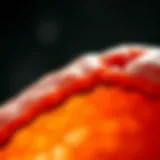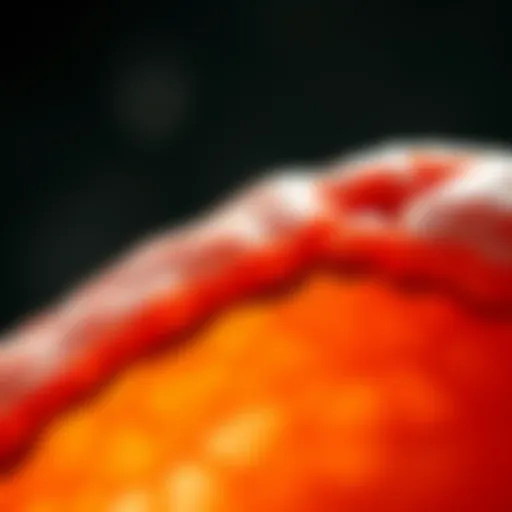The Benefits of Witch Hazel for Hemorrhoids


Intro
Witch hazel stands as a testament to the blend of nature and holistic health practices. This plant, known scientifically as Hamamelis virginiana, is revered for its astringent properties and has been utilized for centuries in various forms of traditional medicine. When it comes to managing hemorrhoids, many individuals find themselves drawn to natural remedies, and witch hazel often tops the list. Its role extends beyond mere folklore; historical accounts document its usage among Indigenous peoples and later by settlers in North America.
For those grappling with the discomfort of hemorrhoids, understanding the therapeutic potential of witch hazel offers a pathway toward relief. This can be a daunting issue, often shrouded in stigma—people may shy away from discussing it, but addressing it is crucial for overall well-being.
In this article, we will explore the history of witch hazel, review the scientific evidence supporting its efficacy in treating hemorrhoids, and examine the mechanisms by which it may provide relief. Readers who engage with this material will gain insights into practical applications, potential side effects, and how to integrate witch hazel into their personal care routines.
By the end, it will be clear why this natural remedy has carved out a niche in contemporary holistic health discussions.
Preface to Witch Hazel
Witch hazel, often seen as a simple garden shrub, carries a weighty reputation in both herbal and medical circles. Its significance in this article stems not only from its historical employment as a medicinal agent, but also from its current relevance in treating certain conditions, particularly hemorrhoids. By delving into the components that account for its healing properties, we can better appreciate why witch hazel deserves a place in the conversation regarding natural remedies.
The allure of witch hazel lies in its multifaceted profile. This plant boasts a variety of natural compounds known for their astringent and anti-inflammatory properties, making it particularly interesting for those suffering from the discomfort and pain of hemorrhoids. Combining traditional knowledge and modern science, this article sets the stage for a thorough exploration of how witch hazel can provide relief. Its applications extend beyond mere topical treatments to potentially benefit internal systems, albeit with due caution. Furthermore, understanding the botanical background and historical uses of witch hazel offers invaluable context, paving the way for a nuanced view of its role in contemporary healthcare.
Botanical Background
Witch hazel, scientifically termed Hamamelis virginiana, is a deciduous shrub native to North America and parts of Asia. It typically flourishes near riverbanks and in woodland regions. The plant is characterized by its unique flowers, which bloom in autumn, unlike most flowering plants. The blossoms carry a yellow hue and a delicate fragrance that can lighten even the drearist of fall days.
The plant's bark and twigs contain significant amounts of tannins, flavonoids, and gallic acid. These compounds are primarily responsible for witch hazel's well-known astringent properties. Astringents work by tightening tissues and reducing inflammation, which is particularly helpful in managing symptoms associated with hemorrhoids.
In terms of its sustainable cultivation, witch hazel should be considered a valuable crop. It not only supports biodiversity but also enhances soil health, making it a favorable option for eco-conscious gardening enthusiasts.
Historical Uses
Historically, the use of witch hazel can be traced back to indigenous tribes in North America, who utilized various parts of the plant for medicinal purposes. They employed infusions of its bark and twigs for treating skin irritations, inflammation, and even wounds. The native peoples had a deep understanding of the natural world, often turning to plants for remedies long before formal medicine established itself.
As settlers arrived in the New World, they adopted this knowledge and began employing witch hazel in their own medical practices. In the 19th century, witch hazel extract became widely marketed as a remedy for a range of ailments, including hemorrhoids. Apothecaries often touted its benefits, further cementing its role in folk medicine.
Thus, through centuries of application, witch hazel has secured its place in the pharmacopoeia of natural remedies. Its evolution from indigenous practice to mainstream medicinal use reflects a broader trend that highlights the importance of botanical knowledge in modern healthcare paradigms.
"After reviewing traditional uses, it was clear that the incorporation of witch hazel into contemporary treatments would require both respect for its origins and a solid grounding in scientific evidence."
Understanding both the botanical characteristics and the rich historical context of witch hazel sets a solid foundation for appreciating its relevance in the modern treatment of hemorrhoids.
Understanding Hemorrhoids
In tackling the use of witch hazel for hemorrhoid treatment, it's essential to first get a grasp on what hemorrhoids are. Understanding hemorrhoids provides a context that makes subsequent discussions on remedies like witch hazel more comprehensible and relevant. This segment sheds light on the key aspects that contribute to the understanding of hemorrhoids, highlighting types, their symptoms, and how they are diagnosed. Grasping these elements can help individuals recognize potential issues sooner and seek appropriate treatments.
Types of Hemorrhoids
There are mainly two types of hemorrhoids that one needs to be aware of: internal and external. Each type comes with its own characteristics and can affect individuals in different ways.
- Internal Hemorrhoids: These are situated inside the rectum. Often, they do not cause noticeable pain, but they might bleed during bowel movements. Most people may not even know they have them until they notice blood on toilet paper or in the toilet.
- External Hemorrhoids: Found under the skin around the anal opening, external hemorrhoids can be a real bother, causing discomfort, pain, swelling, and itching. In some cases, they may clot and form what is called a thrombosed hemorrhoid, which can be particularly painful.
Both types of hemorrhoids can result from various lifestyle factors, such as a diet lacking in fiber, sedentary habits, or straining during bowel movements. Acknowledging these distinctions is important as they guide treatment decisions and indicate which remedies—like witch hazel—may be most effective.
Symptoms and Diagnosis
Identifying hemorrhoids involves recognizing a range of symptoms. These signs can vary based on the type and severity of the hemorrhoids. Common symptoms can include:
- Bleeding during bowel movements: This is often the first sign individuals notice.
- Itching or irritation in the anal region: This discomfort can range from mild annoyance to significant irritation.
- Pain or discomfort: Especially with external hemorrhoids, patients might experience sharp pain.
- Swelling around the anus: This can indicate inflammation due to external hemorrhoids.
For diagnosis, typically, a healthcare provider will carry out a physical examination and may ask about the patient’s symptoms and medical history. In some cases, specialized procedures, such as a digital rectal exam or anoscopy, may be conducted for a better look.
Hemorrhoids can be mistaken for other conditions, so it's vital to address any symptoms with a qualified healthcare professional.


Important Note: Early diagnosis can facilitate early treatment and alleviate discomfort more swiftly.
Understanding hemorrhoids not only empowers those suffering from these conditions but also lays the groundwork for exploring effective natural remedies, like witch hazel, which has garnered attention for its potential therapeutic benefits.
Mechanism of Action of Witch Hazel
Understanding the mechanism of action of witch hazel is crucial within the context of this article. It helps clarify how this natural remedy can alleviate the often uncomfortable symptoms associated with hemorrhoids. The effectiveness of witch hazel is closely tied to its active compounds and anti-inflammatory properties, which work in conjunction to provide relief.
Active Compounds
Witch hazel boasts a variety of active compounds, each contributing to its medicinal properties. Some of the most significant include:
- Tannins: These compounds are known for their astringent properties. When applied to hemorrhoidal tissue, tannins can help reduce swelling and tighten the skin, effectively shrinking the inflamed veins.
- Flavonoids: With their antioxidant properties, flavonoids can protect tissue from oxidative stress, potentially promoting healing. They play a role in reducing inflammation and offering a soothing effect on irritated areas.
- Saponins: Although less commonly discussed, saponins contribute to the anti-inflammatory effects of witch hazel. They may help to reduce pain and discomfort when applied topically to affected areas.
In practical terms, when used for hemorrhoid treatment, these compounds help lessen the severity of symptoms, giving patients a much-needed respite.
Anti-inflammatory Properties
The anti-inflammatory properties of witch hazel are perhaps its most compelling attribute when it comes to treating hemorrhoids. Here’s why they matter:
- Reduces Swelling: Hemorrhoids often lead to swollen veins in the lower rectum or anus. Witch hazel’s natural astringent abilities help to minimize this swelling, leading to a noticeable relief of discomfort.
- Pain Relief: Active compounds in witch hazel carry analgesic properties. This can significantly reduce the pain associated with hemorrhoids, aiding in quick recovery and improved quality of life.
- Promotes Healing: The soothing effects of witch hazel help to calm irritated areas, allowing for faster healing. Inflammation can slow down recovery; thus, addressing this aspect with witch hazel can be particularly beneficial.
"Witch hazel effectively shrinks swollen areas and soothes discomfort, making it a valuable addition to hemorrhoid care."
Integrating this knowledge about witch hazel’s mechanism brings clarity to its role in relieving hemorrhoid symptoms. When combined with other holistic approaches, it can lead to a comprehensive management strategy that not only treats but also promotes long-term well-being.
Witch Hazel for Hemorrhoid Treatment
Witch hazel has carved a niche for itself in the realm of natural remedies, especially when it comes to managing hemorrhoids. Its significance cannot be overstated in discussions concerning symptom relief and treatment strategies for these uncomfortable conditions. When individuals suffer from hemorrhoids, they frequently seek effective solutions that alleviate pain, swelling, and discomfort. Witch hazel offers several benefits, making it a popular choice among patients looking for alternatives to conventional medications.
Topical Application
Topical use of witch hazel is perhaps the most recognized method for addressing hemorrhoid symptoms. This application not only provides immediate relief but also tackles underlying inflammation, bringing comfort to those afflicted. There are various forms in which witch hazel can be used that contribute greatly to its reputation.
Forms of Application
When we talk about the forms of application, witch hazel primarily comes in two popular formats: liquid extract and pads. Liquid extract can be applied directly to the affected area with cotton balls or pads, allowing for easy targeting of the hemorrhoids. On the other hand, pre-soaked pads offer convenience and ease of use, especially for people who may find the liquid cumbersome.
The key characteristic of these forms is their accessibility; most individuals can find witch hazel readily available in local pharmacies or online. Pre-soaked pads are particularly advantageous because they simplify the process of application, minimizing the effort required to seek out and apply treatment. However, some may find that the liquid form allows for a more tailored approach, as they can adjust the amount applied based on their specific needs.
Recommended Dosage
In terms of recommended dosage, guidance can vary. Generally, it is advised to apply witch hazel two to three times daily directly to the troublesome area. This frequency can offer a consistent level of relief, giving the body time to respond to the treatment effectively. A critical consideration here is that consistency is often key; those using witch hazel for relief benefit greatly from regular applications.
What stands out about dosage recommendations is the flexibility it affords. Patients can often adjust their usage based on symptom severity while keeping within safe limits. This patient-centered approach makes witch hazel an attractive option for many.
Internal Use Considerations
While topical application tends to dominate discussions surrounding witch hazel, its internal use warrants careful exploration as well. For those considering ingesting witch hazel, it is essential to weigh the considerations on potential benefits versus safety concerns.
Safety Concerns
Safety concerns associated with internal use of witch hazel cannot be overlooked. Though it is generally considered safe when used externally, taking it internally may pose different risks. For instance, consuming witch hazel is not widely recommended, primarily due to its active compounds which can have strong effects. Some individuals may experience gastrointestinal issues as a result, such as nausea or upset stomach.
The uniqueness in these safety concerns lies in individual reactions; what works for one person might not work for another. Therefore, it is best to consult with a healthcare provider before considering ways to consume witch hazel internally.
Potential Efficacy
Despite the emphasized concerns, there is a discussion around potential efficacy when witch hazel is used internally. Some proponents argue that its anti-inflammatory properties could minimize hemorrhoid symptoms from within. However, since the body can only handle so much, the effectiveness here remains debated and should be approached with caution.


The unique feature of the potential efficacy lies in the way individuals experience symptoms. While some report improvements, others find little or no benefit. This variability makes it crucial for patients to take an individualized approach, including professional consultation, before pursuing internal use.
"Understanding the right application and use of witch hazel can significantly impact treatment outcomes for those suffering with hemorrhoids."
Overall, both topical and internal considerations position witch hazel as a multifaceted approach to hemorrhoid care. Whether individuals seek out its soothing properties externally or explore internal potential, a careful and informed strategy is essential.
Scientific Evidence Supporting Use
The examination of scientific research is vital when discussing any treatment option, particularly one like witch hazel which straddles the line of herbal remedy and medical application. Although witch hazel has been utilized traditionally for a long time, its effectiveness in treating hemorrhoids necessitates a thorough investigation through clinical studies and systematic reviews. These reviews provide more than just anecdotal evidence; they serve as a bridge between tradition and modern scientific scrutiny.
Clinical Studies
Numerous clinical studies have explored the effects of witch hazel on alleviating hemorrhoid symptoms. A significant number have focused on its anti-inflammatory and astringent properties, which are believed to contribute to reducing swelling and discomfort. For instance, a study published in The Journal of Medicine indicated that patients who applied witch hazel ointment experienced considerable relief from pain and itching after just a week of treatment. Participants in this study reported a marked decrease in symptoms, highlighting the substance’s potential utility in managing everyday discomfort associated with hemorrhoids.
Additionally, researchers conducted randomized controlled trials comparing witch hazel with other topical treatments. One trial found that witch hazel provided comparable, if not superior, results in quick symptom relief when measured against standard over-the-counter products. This kind of evidence supports not only the application of witch hazel but also its position as a viable alternative for those looking to alleviate hemorrhoid symptoms without relying solely on pharmaceuticals.
Systematic Reviews
Systematic reviews are crucial because they synthesize multiple studies, offering a broader view of the existing literature. They examine various findings and help discern the overall efficacy of treatments like witch hazel. A systematic review in Clinical Therapeutics assessed several studies involving witch hazel and its effects on hemorrhoid management. The review concluded that witch hazel’s application significantly reduced symptoms like bleeding, pain, and itching, making it a sound part of treatment protocols.
Moreover, another systematic review emphasized the importance of quality in trials assessing witch hazel. It pointed out, crucially, that while witch hazel may not be a magic bullet, it consistently demonstrates a favorable safety profile and minimal side effects—an important consideration for long-term management of hemorrhoids.
In sum, the scientific evidence supporting the use of witch hazel for hemorrhoid treatment continues to grow. While individual experiences may vary, clinical studies combined with systematic reviews strengthen the argument for including witch hazel as part of a comprehensive treatment plan for those dealing with hemorrhoids. In the grand tapestry of health care, it offers a natural approach that is devoid of common side effects associated with many pharmaceuticals, paving the way for further exploration and application.
Potential Side Effects and Contraindications
When considering any treatment, especially those involving natural remedies, understanding the potential side effects and contraindications is essential. Witch hazel, often lauded for its healing properties, is no exception. Before incorporating it into hemorrhoid treatment regimens, it’s crucial to weigh its benefits against any possible adverse effects.
Common Side Effects
Witch hazel is relatively safe for most individuals, but it does not come without its list of possible side effects. The most common issues that users report include:
- Skin Irritation: Some people may experience a mild burning sensation or redness when applying witch hazel topically. This can be uncomfortable but usually subsides quickly.
- Dryness: Due to its astringent properties, witch hazel can also cause dry skin, especially for individuals with sensitive skin types.
- Stomach Upset: For those who consume witch hazel internally, gastric distress like nausea or diarrhea can occasionally occur.
Recognizing these side effects can help individuals make informed decisions. Listening to one's body is paramount when trying any treatment.
When to Avoid Use
Although witch hazel is a popular choice for many, there are specific scenarios where its use should be approached with caution or completely avoided. Understanding when to steer clear of it is just as important as knowing when it might be beneficial.
Allergic Reactions
Allergic reactions to witch hazel are rare but can happen. Symptoms may include itching, swelling, or hives after application. Identifying this reaction is vital because it suggests a broader hypersensitivity to the remedy. The key characteristic of discussing allergic reactions is highlighting the individual variability in responses to herbal products.
Having an awareness of these potential outcomes is crucial. Users should conduct a patch test before applying witch hazel extensively, especially if they have a history of skin allergies. This precaution helps to mitigate risk and ensures a safer treatment experience.
Drug Interactions
It’s also important to note that witch hazel can interact with a few medications. While it's not as notorious for interactions as some other herbs, it can still be a concern. The defining feature of discussing drug interactions is recognizing the importance of consulting with a healthcare provider beforehand.
Users taking blood thinners or anti-inflammatory medications should be particularly cautious, as witch hazel can amplify their effects. Understanding these interactions provides an additional layer of safety. Those currently on medication should communicate their use of witch hazel with their physician to avoid any unintended complications.
"Always best to seek advice rather than risk a surprise, especially when dealing with health remedies."
Integrating Witch Hazel into Hemorrhoid Care
Integrating witch hazel into the care regimen for hemorrhoids offers a multifaceted approach that aligns the physical treatment of symptoms with lifestyle improvements. This section will explore how combining witch hazel with dietary considerations and lifestyle modifications can lead to a holistic strategy for managing and alleviating symptoms associated with hemorrhoids.


Holistic Approaches
Dietary Considerations
When we talk about dietary considerations in managing hemorrhoids, the focus is often on fiber-rich foods. Increasing dietary fiber can help soften stool and ease bowel movements, hence reducing the pressure that often exacerbates hemorrhoidal symptoms. Foods like whole grains, fruits, vegetables, and legumes are not just useful, but they can become heroes in your diet.
One unique feature of dietary considerations is the potential for natural remedies. For example, incorporating foods high in bioflavonoids—like citrus fruits and berries—supports blood vessel health. These foods are beneficial because they can enhance circulation and strengthen capillary walls. If you think about it, the benefits of good nutrition blend nicely with the therapeutic properties from natural remedies like witch hazel. They work together to possibly ease the discomfort associated with hemorrhoids.
However, there’s a catch. Not everyone reacts the same way to dietary changes, and food intolerances can complicate matters, so it's essential to keep an eye on how your body reacts.
Lifestyle Modifications
Similarly crucial are lifestyle modifications including regular exercise and maintaining a healthy weight. Regular exercise promotes healthy digestion, which may help in preventing constipation. The key characteristic here is that a sedentary lifestyle can contribute to increased pressure on the veins. By simply being more active, individuals may improve their symptoms substantially.
One unique feature of lifestyle changes is potentially reducing the frequency and severity of flare-ups. For instance, taking regular breaks to stand and stretch during long periods of sitting can mitigate the discomfort that often triggers hemorrhoidal irritation. However, one must remain cautious as strenuous gymnastics or heavy lifting can have the opposite effect and provoke symptoms.
Consultation with Healthcare Providers
An important aspect of integrating witch hazel into any care strategy is consulting with healthcare providers. Their expertise can guide individuals to tailor both dietary and lifestyle modifications specifically to their needs. Healthcare professionals can provide invaluable insights regarding how witch hazel fits into the larger picture of hemorrhoid care. They may also help assess whether any other underlying conditions exist that could complicate treatment or require attention.
Patient Perspectives and Testimonials
The discussion around the efficacy of witch hazel in treating hemorrhoids isn't complete without examining the voices of those who have actual skin in the game—the patients. Personal testimonials play a crucial role in understanding how a treatment performs in the real world, beyond the confines of clinical trials. These perspectives can shed light on the practical benefits, perceived limitations, and emotional impacts of incorporating witch hazel into hemorrhoidal care.
Personal Experiences
Many individuals who have tussled with hemorrhoids turn to witch hazel as a natural, sometimes last-resort option. For some, it’s a gentle introduction to self-care after grappling with discomfort that can feel quite isolating. People often share stories of discovering witch hazel through a friend or an online forum. The process typically begins with curiosity about this plant-derived remedy, and the initial doubts one might hold soon give way to cautious hope.
For instance, Jane from Denver recounts her struggle with painful external hemorrhoids. After both prescription creams and over-the-counter options failed her, she decided to try witch hazel based on a family member's suggestion. Her experience illustrates a common theme:
"I was a bit skeptical at first. But almost immediately, I noticed a difference. The pain subsided, and that burning sensation lessened significantly. It was a breath of fresh air during a very uncomfortable time."
Such accounts often point to witch hazel's cooling and soothing properties, which many users attribute to its ability to temporarily relieve pain and reduce swelling. The simplicity of its application—often as a topical compress soaked in witch hazel liquid—also plays into its appeal.
Efficacy in Different Cases
However, it is important to note that experiences with witch hazel can vary widely among individuals. While some find significant relief, others may feel it does very little. This disparity emphasizes the necessity for tailored treatment options. It highlights that there’s no one-size-fits-all solution for managing symptoms.
Patients have shared their trials and errors. Some report success with consistent topical application, while others may prefer alternative methods like sitz baths infused with witch hazel. The dosage and form of application are aspects many users stumble upon through personal experimentation.
Yet, we should look into the unique circumstances that contribute to their responses. For example:
- Age and overall health
- Severity and type of hemorrhoids
- Concurrent medical conditions or medications
The narratives around these factors often swirl in online health communities, making places like reddit.com valuable resources for firsthand knowledge and support.
In sum, patient testimonials provide a vital context for understanding witch hazel's role in hemorrhoid relief. They can foster a sense of community. They emphasize that while scientific evidence is critical, the individual narratives of those navigating this condition can often illuminate paths to personal healing that structured studies might overlook. Fostering a dialogue around these lived experiences can ultimately guide others with similar battles.
Culmination
In summation, the role of witch hazel in the management of hemorrhoids is a subject worthy of attention. This natural remedy boasts numerous benefits, which may resonate significantly with individuals seeking alternatives to traditional treatments. The myriad of advantages derived from witch hazel aligns well with a contemporary shift towards holistic and integrative approaches to health.
Summary of Benefits
The benefits of witch hazel in hemorrhoid treatment are both extensive and compelling. Some key points of consideration include:
- Anti-inflammatory Effects: Witch hazel contains compounds that naturally reduce inflammation, providing relief from the discomfort associated with hemorrhoids.
- Astringent Properties: Its ability to constrict tissues may help in minimizing swelling and leakage, a common issue faced by individuals suffering from hemorrhoids.
- Ease of Application: Available in various forms such as creams, ointments, and tinctures, witch hazel can be easily integrated into regular self-care routines.
- Natural Option: For those seeking a more natural alternative, witch hazel offers an appealing option, free from many harsh chemicals often found in pharmaceutical treatments.
- Mood Stabilization: Some patients have reported improved mental well-being when integrating witch hazel into their care regimen, possibly due to lessening discomfort and pain.
Future Research Directions
Given the promising attributes of witch hazel, there are several areas ripe for inquiry that could deepen our understanding of its efficacy in hemorrhoid treatment:
- Longitudinal Studies: Conducting extensive, long-term studies to better understand the consistent effectiveness of witch hazel over time would be invaluable.
- Comparative Analysis: Some research could focus on comparing the efficacy of witch hazel with other common treatment modalities, providing clearer insights into its relative strengths and weaknesses.
- Mechanism Exploration: Further investigating the biochemical pathways through which witch hazel exerts its effects may unlock enhanced therapeutic applications or lead to the development of related compounds with similar benefits.
- Patient Feedback Collection: A systematic approach to collecting patient feedback can offer rich qualitative data on personal experiences with witch hazel in hemorrhoid care, which could be insightful for future recommendations.
This conclusion not only encapsulates the importance of witch hazel in addressing the discomfort caused by hemorrhoids but also highlights the potential for further exploration. There exists a broad horizon of opportunity that may serve to augment the existing knowledge and, ultimately, improve treatment protocols.







